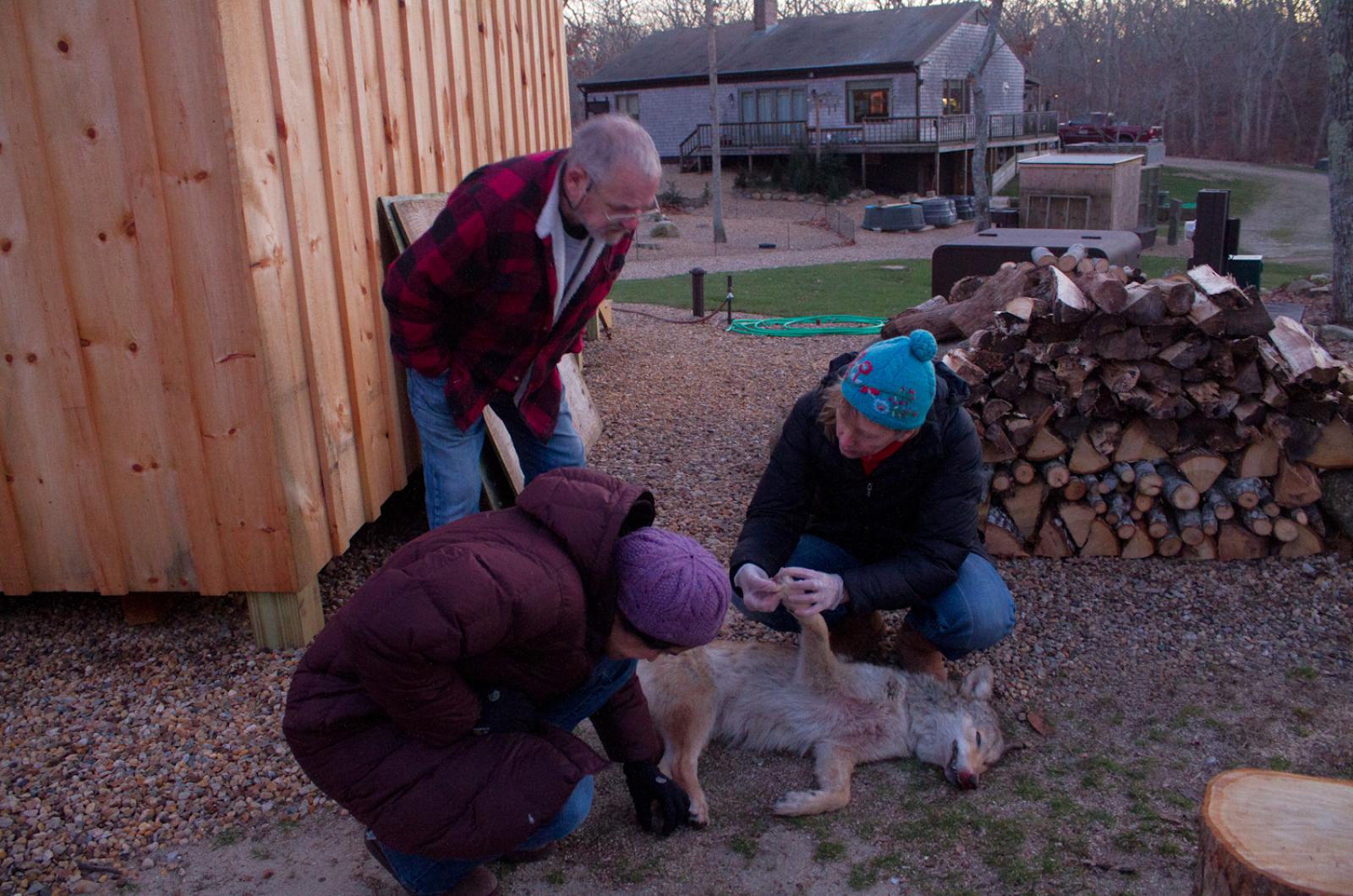Alison Oestericher and her Border collie Sen spend time each day walking along Vineyard beaches, with Ms. Oestericher taking in the scenery and Sen doing his best to herd the waves that lap the shore. They have seen countless strange things washed up on the beach, including one of Ms. Oestericher’s boots that she’d lost some months before.
On Monday afternoon, the pair were out walking on Lambert’s Cove Beach when they added another sighting to the list: a dead coyote that had washed ashore.
Ms. Oestericher was shocked to see the animal, although she wasn’t sure what it was. Sen jumped over it, uninterested. Ms. Oestericher called to a couple walking nearby, who said it was a coyote.
West Tisbury assistant animal control officer Allen Healy was called, as were state wildlife officials. Ms. Oestericher posted a photograph of the coyote to her Facebook account, and the image made its way back to Luanne Johnson and Liz Baldwin of Biodiversity Works.
“In the realm of dead things you find on the beach, this is unusual,” Ms. Johnson said on Tuesday. She and Ms. Baldwin brought the coyote to naturalist Gus Ben David’s after taking it off the beach and recording the finding with a database. State laws dictate protocol for handling furbearing animals.
“You can’t just go out and grab a coyote,” Ms. Johnson said.
BiodiversityWorks also has a database that is Island-specific, to note when coyotes are found on the Vineyard. This coyote is the second to wash up on Lambert’s Cove Beach in the past year. In March, a female coyote was found by Ebba Hierta and Chuck Hodgkinson.
“There are three that we know officially that have been washed up,” Mr. Ben David said.
Adaptable and elusive, coyotes live in every part of Massachusetts except for Martha’s Vineyard and Nantucket. They established a population on Cape Cod in the early 2000s, but have been living on the Elizabeth Islands since the 1980s. Throughout the years, occasional sightings of coyotes have been reported on the Vineyard but only one has been confirmed with photo evidence, Mr. Ben David said. That was in 2009, when Ms. Baldwin photographed a coyote on the north shore.
“When you hear of a coyote sighting, you don’t take them with a grain of salt, but it’s like a rare bird sighting,” Mr. Ben David said. “You ask a lot of questions.”
A few years ago, he said, a lone coyote was spotted in West Tisbury, near the Granary Gallery. Mr. Ben David said that he usually expects calls to come in at this time of year, during hunting season when there are more people out in the woods and likely to notice an unusual animal. But he has had no coyote reports so far.
“I don’t believe right now that we have any on the Vineyard,” Mr. Ben David said.
The coyote found on Lambert’s Cove had a pale red-orange coat of thick fur, tinged with shades of gray and brown. Its tail was bushy, with a noticeable black tip. The tail and tail markings are usually a good way to identify whether or not an animal is a coyote, Ms. Johnson said.
“The tail, the shape of the head, the coloring,” she said.
Mr. Ben David said that another giveaway was its snout. “A very narrow snout,” he said, “It’s different from a [dog], which is more rounded.”
Mr. Ben David said he was 95 per cent sure the animal died because of drowning. Hypothermia was a possibility, he said, but “a dog can be in the water a long time, and this one’s well-insulated. We never know for sure.”
Ms. Johnson said that Tom French, the assistant director of the natural heritage and endangered species division at the Massachusetts Division of Fisheries and Wildlife, had reached the same conclusion after she reported the coyote to him. In an email to Ms. Johnson, Mr. French noted that the Elizabeth Islands are “loaded with coyotes.”
“Making the swim from Nashawena to Cuttyhunk with the out-going tide pouring south through the channel would push them right to the Vineyard,” Mr. French wrote.
“You can imagine they’re swimming between the islands, they get sucked out into the currents,” Ms. Johnson said. And mating season is about to begin, so animals are on the move. “They don’t really know about currents, just like people,” Ms. Johnson said.
Mr. Ben David said it was very likely the animal had come from Naushon, which is directly across Vineyard Sound from Lambert’s Cove Beach. Naushon hosts a relatively large population of coyotes. At one point there were as many as 25, Mr. Ben David said. But in all his years visiting the island, he added, he had never seen a coyote with such a striking red color. A person looking at it from a distance might think it was a fox.
“The sides are usually darker,” Ms. Johnson said. “Coyotes do have a wide range of colors.” She said that the coyote was in its prime. “This isn’t some young, sub-adult male.”
Mr. Ben David estimated that the coyote had easily weighed more than 40 pounds before it had died. Male coyotes typically weigh between 34 and 47 pounds, according to the state department of fisheries and wildlife.
“We had a hard time getting it off the beach,” Ms. Johnson said. She said she had reached out to the state to see if someone might want to create a taxidermed mount for educational purposes. Its pelt was in pristine condition as well, and could be tanned.
“Everything’s perfect on it,” Mr. Ben David said.
“You basically try to make the best of it,” Ms. Johnson said.






Comments (9)
Comments
Comment policy »